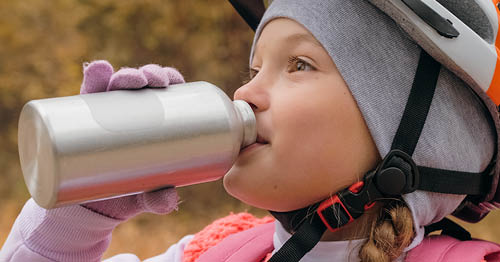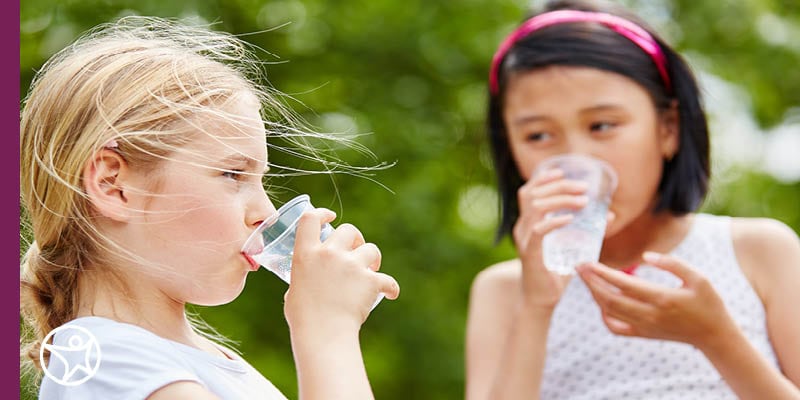Setting Healthy Screen Time Limits for Students Learning Online
by Julie Hersum
byKristina Cappetta
6 min to readNot drinking enough water throughout the day can impact a person’s health and academic performance, but do you know how much water kids should drink a day? Learning Coaches and caregivers can help their students drink enough water to stay healthy and on track with their learning plan and activities throughout the day.
According to Children’s Health, children and teenagers on average need more water as they grow. Pediatricians recommend:
4–8-year-olds drink 4 cups of water a day
9–13-year-olds drink 7-6 cups of water a day
14–18-year-olds drink 8-11 cups of water a day
People should drink close to half an ounce of water for each pound of weight. For example, if your child weighs 100 pounds, they should be drinking about 50 ounces of water daily. That equals a little more than six 8-ounce glasses.
Encourage your student to have a glass of water with each meal and carry a water bottle with them so that they can sip throughout the day. Encourage them to not only drink water, but also other hydrating beverages such as milk. Milk contains protein and some fat which can slow fluids from emptying, keeping the body hydrated for longer. Avoid juices and soda because they are less hydrating.
Because every child’s health needs are different, it’s important to seek advice from your pediatrician who can give specific advice when it comes to how much water your child is drinking and if you should increase water intake.
When kids are not drinking enough water, they can become dehydrated. Signs of dehydration include:
Headache
Lightheadedness
Trouble focusing
Flushed skin
Urinating infrequently or dark-colored urine
Cramps
Rapid Pulse
Feeling excessively hot or cold
Sleepy
Sticky, dry mouth
If your child shows any of these symptoms regularly, consult your pediatrician, who can help determine if inadequate water intake could be to blame.

When your child is not getting enough water, there are some things you can try to do to increase their daily water intake.
As you explore how to get kids to drink water, consider downloading a water-tracking and reminder app. Here are some apps to help you track. These apps help children to pace themselves when it comes to their daily water intake. Since the body can only process so much water at once, health issues can arise when too much water is consumed at the same time.
Tummyfish for iOS and Android helps to teach kids the importance of drinking water. By using rewards and games, kids can gradually form good water-drinking habits. Learning Coaches and caregivers can create a Tummyfish and set notifications for when children need to drink water. The app tracks water consumption and progress by giving weekly and daily statistics. Kids can play games and see how water and sugary drinks affect the Tummyfish and her environment. This app is recommended for kids ages 4-12.
Plant Nanny is a customized water tracker and drink water reminder game aimed at getting users to drink more water and meet their water intake goals. As kids document each glass of water they drink, they make the plants on the app grow. Caregivers and Learning Coaches can help kids set a daily schedule so that they are getting enough water and help to keep their online plants growing. There are also reminders to help keep kids on track. Charts mark progress so kids and adults can see when daily goals are met. Plant Nanny is recommended for kids ages 4 and up.
Add some of their favorite sliced fruits, berries, or cucumber slices into the water pitcher or try a water bottle with a built-in infuser. Some kids like how water tastes this way rather than plain water. Be sure not to add too much fruit, though, because you don’t want the water to become too sugary.
If access to water is an issue, encourage children to carry a water bottle with them. Allow children to pick out a water bottle that they like. By giving them a choice, it offers them a sense of ownership and may help to increase water intake, as they are happy to bring it with them as they go about their day. There are many trendy bottles and cups on the market now that allow kids to make a water bottle an accessory. You may also want to find a larger bottle with different ounce markings so they know how much water they should be drinking. Many times, kids simply don’t know when and how much water they should be drinking. Setting reminders to drink hourly can also help to increase water intake.
Use this to encourage them to stay hydrated throughout the day.
When kids drink too many sugary beverages, often they’re not drinking enough water to meet their daily needs. Researchers believe that too much sugar can lead to dehydration—even in drinks. This can be due to the way sugar and water interact within the cells. Higher sugar intake can make the cells in the body transfer more water, making children go to the bathroom more frequently and they can become dehydrated before their cells can absorb all the water.
Teens who may opt for coffee and tea need to watch their caffeine intake. While drinks like black coffee or plain tea can help to meet water intake requirements, they can have dehydrating effects when drinking too much or adding sugar, cream, or flavored syrups. Instead, encourage your teen to drink a full glass of water along with their caffeinated drink to balance out the effects.
Keep an eye on their energy drink consumption as well because these drinks are high in sugar and caffeine and low in water. While they are still getting some water into their systems, they’re not getting as much hydration as they would with a regular glass of water.
Be a good role model for your child by drinking more water instead of soda, juice, or other sugary drinks. If they see you do it, they may be more apt to follow.
When students are studying, they may not eat well or forget to eat at all. Encourage them to take healthy study breaks that include water and nutritious snacks. This will give them the fuel they need to get their work done while staying adequately hydrated.
By knowing how much water a child should drink and how much water a teenager should drink, you can help your child stay healthy and alert during their school lessons. If you are unsure whether your child is drinking enough water every day, consult your pediatrician. They can give you the best advice for your child and their specific dietary needs based on their weight and other factors.
